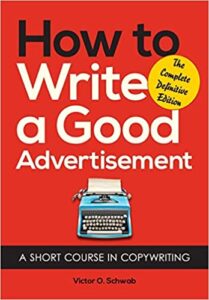Learning how to write adverts that grab your customer’s attention, sparks their interest, and generates sales is a key skill that every marketer must learn.
In this series of posts, we are talking about the 5 fundamental purposes of an ad.
To summarise, the 5 fundamental purposes of a successful ad are:
- To get attention
- To show an advantage that can be obtained through the use of your product or service
- To prove your claims
- To persuade people to grasp the advantage
- To ask people to take action
The 1st fundamental purpose of an ad is to get attention, the 2nd is to show your audience an advantage that can be gained from using your product, and the 3rd is to prove those claims.
In this post, we will be taking a close look at the 3rd fundamental purpose of an ad, which is to prove your claims.
Prove your claims -Ad fundamental #3

When you have shown people an advantage or result that can be obtained from using your product or service your next job is to prove those claims.
You can’t expect people to take your claims at face value. If they have never purchased anything from you or had any sort of experience with you or your brand they will have no reason to trust you yet.
When you make the claim that your product or service can help them to get the result they want you will have to offer some proof of your claims.
You can show proof anywhere in your ad
There’s a very important note to be made here in regard to the sequence of your ad copy.
Even though proving your claims is the 3rd fundamental purpose of an ad, it doesn’t mean that the “proof material” has to be presented in that order when it comes to the actual preparation of your ad copy.
You may find that you can use a proof statement in your headline, as these sorts of headlines are very effective at grabbing attention (the 1st fundamental of an ad), and then start to assert your advantages (the 2nd fundamental of an ad).
Or you may make your proof statements in the first part of the body of your ad copy, and then follow it with your advantage claims. This is known as inductive ad copy – you display your proof material first and then make your assertions of the resultant advantages afterwards.
Deductive ad copy is where you begin with your assertions of advantages and then offer your proof statements. This is the more commonly used approach when it comes to ad copywriting.
In order to prove your claims you will need to make use of facts.
The importance of facts
It is important to have as many facts as possible in your ad copy that back up your claims.
There are two main reasons why facts are so important:
1. They make your claims more credible
People are inundated with ads nowadays. We see them on every YouTube video we watch, on billboards, in newspapers and magazines, on banner ads, on the side of buses etc.
We are living in an age where there is an overload of advertising stimuli coming at us from all angles. Because of these we no longer take the claims made by advertisers very seriously. We need something more concrete than their word in order to convince us about the advantage they are claiming to offer. Facts are vital in lending credibility to your claims.
The more facts you can include in your copy, especially facts from reputable sources or third parties, the more credible your ad and everything in it will be.
2. Facts give us a logical reason to buy
You’ve probably heard the saying “people buy on emotion and justify with logic”. In part 2 of this series of posts, we talked about the 2nd purpose of an advert which is to show people an advantage. You do this by tapping into the psychology of your target market and understanding what they want to gain, be, do and reduce.
When you know their desires you then tie up the advantages of your products to them – this is done on an emotional level. Once you have triggered an emotional desire to buy you need to give your prospects reasons to justify their purchase logically – this is where facts come in. Your prospects want and need facts as reasons (and excuses) to buy your product, so give them what they want!
Once you have sold them on your product emotionally you need to help them justify the purchase logically, and facts serve this purpose well.
Your prospects want to believe your claims
If you have done a good job of selling the advantages of your product on an emotional level, your prospects will want to believe your claims and will be looking for evidence to do so.
They have been waiting for a solution to their problem and you have successfully tapped in to their emotions and convinced them that your product is what they have been waiting for.
They have already accepted your claims emotionally. They can already see themselves enjoying the advantages and results that your product offers them and they don’t want to let this go – they want to reinforce it.
When they are in this frame of mind they will more readily accept the facts you present to them. They will be more predisposed to accepting your proof statements.
The types of facts to use
There are several types of facts you can use to prove your claims.
1. Performance facts and evidence
Product achievements
How does your product perform under certain conditions?
Does it help your prospect to get a certain result within a certain time period?
Does it offer a new, innovative solution?
Performance tests vs competitors
How does your product stack up against the competition?
Include any tests that you have put your product under and share the results. You can do a side by side comparison of your results and illustrate them in a chart or graph.
Before and after
A well-known technique used to demonstrate the before and after effects gained by using your product. Make sure you use good quality images that clearly demonstrate the results.
Popularity metrics
Talk about how many units you have sold, how many customers you have helped, or by how much you have outsold rival products.
If your sales figures for your product are constantly increasing then mention it. Increasing popularity means that your product must be delivering results and living up to its claims.
2. Social proof
User testimonials
Use testimonials from users who have used your product to successfully achieve the advantages you promised. This demonstrates to prospects that people just like them have gained success and convinces them that they can too.
Influencer testimonials
Where possible, try and gather testimonials from people who are experts in the field or market to which your product belongs.
Having a testimonial from someone who has a lot of influence with your target market using your product lends a huge amount of credibility to your claims.
Authority endorsements
Are there any governing or regulatory bodies, organisations, or associations in the industry you are in? Perhaps there are well known authorities or experts in your niche.
If so, having their seal of approval on your product will reap huge rewards and help to establish trust and lend credibility to your claims as well as to your product, brand, and business.
Reviews
Sharing your ratings on services like TrustPilot can add instant credibility to your claims and your facts.
Industry awards or competitions won
If your product or service has won any sort of awards or competitions then make sure to include that in your ad copy. This will validate your claims and show that your product or service is highly regarded in your market or industry.
3. Production and manufacturing facts
Reputation
Does your company have a good longstanding reputation in your market? If so mention it.
People will be reassured when they know they are buying from an established company with a long history and good reputation.
Production quality
Share facts about the long-experienced craftsman, designers, and skill of the people behind your product.
Expertise and experience
What sort of combined experience do you or the people behind your product have?
If you can quantify this in years or achievements you will add instant credibility and trust to your claims.
Example: “Our award winning team have a combined 55 years experience in the health and fitness industry”.
Quality of design or manufacturing
Has your product been designed in any specific way which allows it to deliver the results better, faster, or more efficiently than anything else on the market?
Is there some unique patented design or manufacturing process used that is exclusive to you and which makes your product more desirable and unique?
How to present your facts
Now you know what sort of facts to present there are some things you need to keep in mind in terms of how to present them.
Be specific
When you are making any sort of claim you should always be as specific as possible. Specificity lends credibility and believability to your claims. If you are using numbers to substantiate your claims then use specific numbers rather than rounding up or down.
Example: “Learn how I made an extra $1,357 every month in my spare time using my proven formula for trading the market”
The use of a specific amount like $1,357 seems more believable and real than a more rounded figure like $1,350, therefore making the statement more credible.
Don’t try to be perfect
There’s no such thing as a perfect product or one-size-fits-all solution, so don’t try to present your product or service as such. Be honest and let people know the truth.
If your product has a 94% success rate then state that. Don’t try to make it 100% unless that’s the absolute truth and you can prove it.
Use images to illustrate your point
Use images to illustrate and support your facts where possible. Before and after pics work well (as long as they clearly show the same person in both photos!).
If you have won any awards or done any tests, share images which show the award or test results.
State facts from the customer’s perspective
If you are talking about your product’s specifications try and break down those specs and present them in everyday language that your target market can understand.
Of course, a percentage of your target market will understand the technical terms, but as a general rule of thumb, you should use language that is easy to understand and has a wider appeal.
Summary
Learning how to write adverts is an important skill for any marketer to learn. It is a skill that can reward you handsomely when you learn how to write ads the right way, by incorporating the 5 ad fundamentals.
The 3rd fundamental of an ad is to prove the claims you made when you stated the advantages of your product.
You can do this with inductive ad copy – you display your proof material first and then make your assertions of the resultant advantages afterwards.
Or the most common approach is to use deductive ad copy: you begin with your assertions of advantages and then offer your proof statements. This is the more commonly used approach when it comes to ad copywriting.
People buy on emotion and justify with logic. You need to use facts to logically backup and prove your claims. If you do a good job at using emotions to show your advantage then you are pre-framing your prospects to readily accept your facts.
They will want to accept your facts because they need a logical reason or excuse to buy your product which you have already convinced them about on an emotional level. There are a number of different facts you can present but you should always be specific where possible, avoid trying to be perfect, and use language and terminology that your prospects will understand.
So far we have learnt that an ad has 5 fundamental purposes.
Here is a summary of the 5 ad fundamentals. If you want to read more about each fundamental just click on the link.
1st fundamental – to get attention
2nd fundamental – to show people an advantage
3rd fundamental – to prove it




